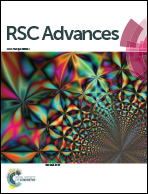A novel approach for the synthesis of hydrogel nanoparticles and a removal study of reactive dyes from industrial effluent†
Abstract
A novel amphoteric monomer, N,N-diallyl carboxypiperidinium bromide (DACPB), has been synthesized by the stepwise condensation of isonipecotic acid to an ester and then with allyl chloride and allyl bromide. The present research study highlights the UV-irradiation synthesis of poly(NIPAAm/DACPB/APTAC) superabsorbent nanohydrogels by free radical polymerization. Nanohydrogel (VUV-05) shows faster swelling and a greater swelling percentage (∼43 000%), which was responsible for the high adsorption of dyes, than that in our previous research study. The synthesized nanohydrogel (VUV-05) was applied for a removal study of Reactive Red 152 dye from industrial effluent. Also, a removal study for a mixture of three reactive dyes, namely Reactive Red 195, Reactive Blue 222 and Reactive Black 5, was carried out from a sole industrial effluent. The nanohydrogels with and without dye adsorption were characterized by FT-IR, TGA, SEM and zeta potential analysis. The effect of parameters such as the initial dye concentration, treatment time, pH, and adsorbent dose were investigated to determine the maximum adsorption. From the removal study it was observed that ∼87% of RR-152 dye can be removed from industrial effluent. Also, the nanohydrogel was able to remove the mixture of reactive dyes, and its removal efficiency was 53.14%, 51.90% and 51.06% for RR-195, RB-222 and RB-5 from a lone industrial effluent (30%), respectively. After the removal study, it was concluded that the pseudo-second order and Langmuir models may well describe the Reactive Red 152 dye adsorption process.


 Please wait while we load your content...
Please wait while we load your content...